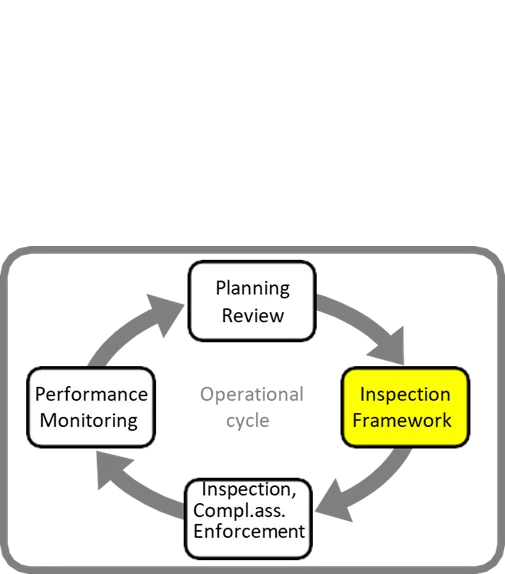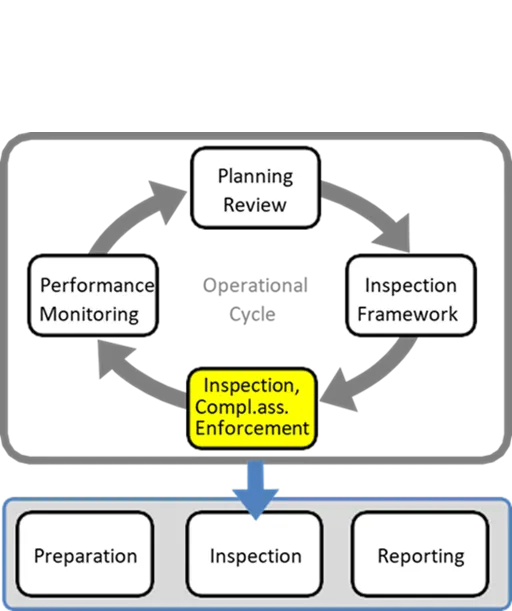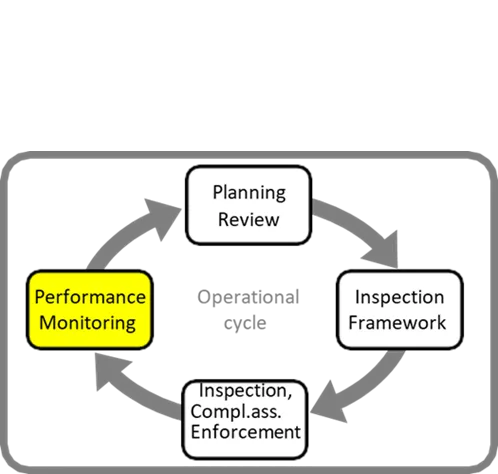|
Objective To find out what conditions are in place to enable inspectors and other staff to carry out inspection activities; how the routine and non-routine inspection activities are actually carried out and reported and follow up is initiated; how inspection data is stored, used and communicated; and how the performance, environmental and other outcomes are assessed. |
C2. Operational Cycle

C2.1. Inspection framework
Guidance:
The review team should gain an understanding on how the authority supports inspectors to carry out their work in an efficient and effective way. This should be done by examining what tools and resources are in place and how good quality work is ensured.
Note: Some issues may already be dealt with in part A or B of this questionnaire.
Topics to consider
- Authorisations and competencies, protocols and working instructions for routine and non-routine inspections.
- Procedures for issuing notices, imposing sanctions etc.
- Inspection and enforcement handbooks.
- Protocols for communication with the public (access to information) and with operators
- Information management (e.g. information systems) and information exchange (within the organisation and with partner organisations).
- Systems for planning, programming and monitoring.
- Equipment (e.g. sampling equipment, computers, means of transport, means of communication).
- Qualifications of staff
- Qualifications, skills and experience required for inspectors and administrative and legal staff
- Procedures for recruitment of inspectors
- Inspector’s ethics. Combating issue-blindness.
- Training
- Procedures for assessment of training needs including training requirements of individual inspectors against necessary qualifications, skills and experience
- Procedures for training inspection staff including the training of new policy, legislation and technical developments and the refreshment of skills and knowledge of existing staff
- Evaluation of results of training
- Opportunities for secondment or exchange of inspectors to other relevant environmental authorities.
- Awareness of relevant technical, policy and regulatory developments maintained within the Inspectorate.
- Guidance
- What technical and other guidance is available to help staff perform inspection activities?
- Access to any advisory body or any other external, independent source of advice.

C2.2. Inspection, Compliance assessment and Enforcement
Guidance
The review team should gain an understanding on how inspections are executed; what the role and responsibility of the inspectors and other staff are.
Topics to consider
- Announced and unannounced routine inspection activities (e.g. site visits; requesting data from operators) when are they performed and how?
- Communication on inspection activities with the operator of an installation.
- Communication on inspection activities with other inspecting authorities.
- Inspections related to issuing new or revised permits.
- Communication on inspection activities and with the permitting authority; content and quality of permits in relation to inspection activities.
- Conducting non-routine inspections associated with complaints, accidents and emergencies.
- Taking enforcement action.
- Making information on inspections carried out available to the public.
- Dealing with accidents on installations subject to the Seveso II Directive.
- Dealing with the complaints, including for example SEVESO accidents.
- Systems used to collect and store data on the Inspectorate’s activities. Use of these data. Target audiences.

C2.3. Performance monitoring
Guidance
The review team should gain understanding on what systems are in place to measure the performance of the authority, what is measured and how the data produced is used.
Topics to consider
- What performance indicators are used in the authority; what data is collected? How is it collected, assessed and used?
- Evaluation of output and the environmental outcome of inspection activities. Use of this information in the Environmental Inspection Cycle.
